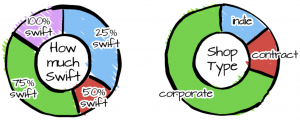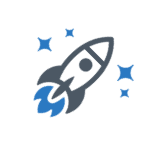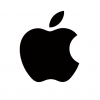At 2014 Apple introduced its new general-purpose, multi-paradigm, compiled programming language called Swift. It’s an alternative to the Objective-C language that employs modern programming-language theory concepts and strives to present a simpler syntax. During its introduction, it was described simply as “Objective-C without the C”. After version 3.0, we kinda say it’s production ready, it’s excellent for learning proposes and in-house apps, but not always sufficient for enormous corporate products on it’s own.

Left: rough percentage of Swift code used in projects. Right: current usage by sectors
For learning the basics of Swift language, you will only need a browser and the IBM Swift Sandbox where you can get familiar with the syntax and more
It’s important to learn the basics of the swift programming language before going right into building applications with user interfaces. If you already have some experience in another programming language, you may want to pick up the swift syntax real quick, and then move into developing apps
Native iOS development can only be done on macOS or formerly know OS X which is Apple’s Unix-based graphical operating systems. The easy way is buying a Macintosh computer with is preinstalled with one of the macOS versions. However they are expensive to buy, but there must be a way to get a macOS up and running, right? Well, sort of. The easiest way is to subscribe to a cloud based solution like MacInCloud, which as it’s name implies gives you a Mac in the Cloud for a monthly fee. Or if you own a powerful Intel based PC, than you can try to install it on a virtual machine or even install it directly and make your own Hacintosh. However those ways are unofficial and unstable and we not gonna disquss it any further.
Most of Apple’s sensors are only available on real devices. So, it’s highly recommended to own at least an up to date iPhone, not only for testing, but to get familiar about how a specific sensor should be used for unique features. But from now on, you can start your journey to become an iOS developer with the iOS Simulator.







